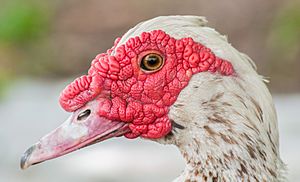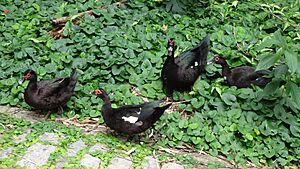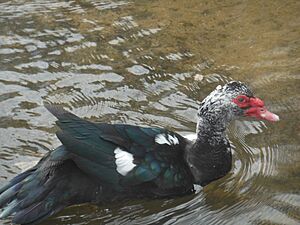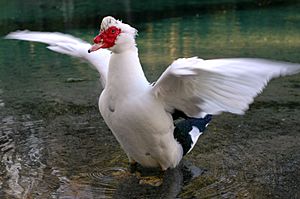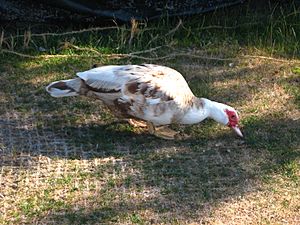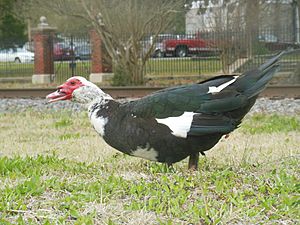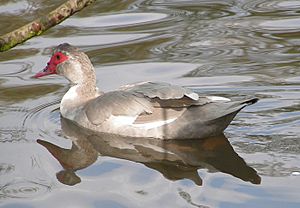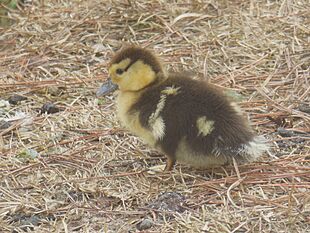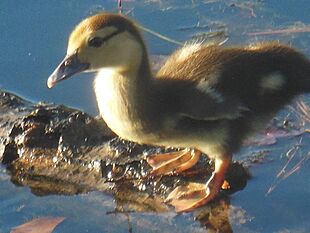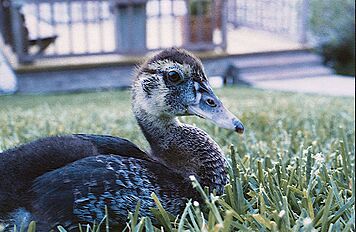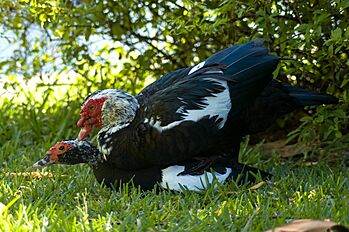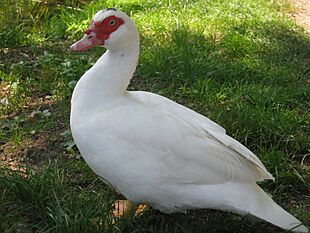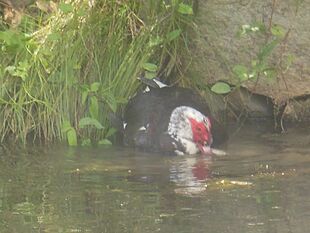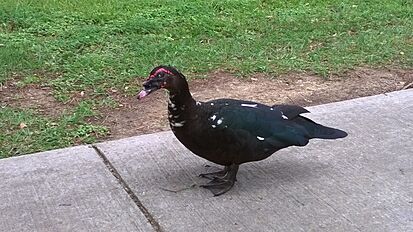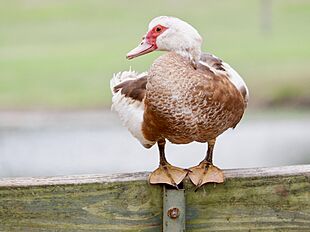Muscovy duck facts for kids
Quick facts for kids Muscovy duck |
|
|---|---|
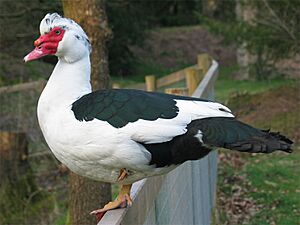 |
|
| Conservation status | |
| Scientific classification | |
| Genus: |
Cairina
|
| Species: |
moschata
|
| Subspecies | |
|
|
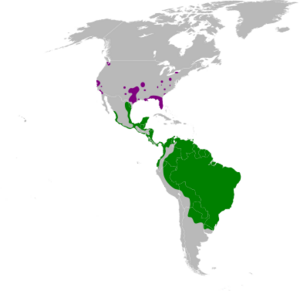 |
|
| Synonyms | |
|
Anas moschata Linnaeus, 1758 |
|
The Muscovy duck (Cairina moschata) is a large duck that comes from the Americas. You can find them from the Rio Grande Valley in Texas and Mexico all the way south to Argentina and Uruguay. These ducks are also found living wild in places like New Zealand, Australia, and parts of Central and Eastern Europe. Some wild groups have even settled in the United States, especially in Florida, Louisiana, Massachusetts, and Hawaii. You can also spot them in other parts of North America, including southern Canada.
Muscovy ducks are quite big! Male ducks, called drakes, can be about 76 cm (30 in) long and weigh up to 7 kg (15 lb). Female ducks, called hens, are much smaller. They only grow to about 3 kg (6.6 lb), which is about half the size of the males. Most Muscovy ducks are black and white. The males have shiny, colorful feathers on their backs, while the females look a bit plainer. The amount of white on their neck and head can be different for each duck. Their bills can be yellow, pink, black, or a mix of these colors. They might also have white spots or stripes on their wings, which are easier to see when they fly. Both male and female Muscovy ducks have pink or red skin around their bills, called wattles. The males' wattles are usually bigger and brighter.
Even though Muscovy ducks are tropical birds, they can live in colder places. They do well in temperatures as low as −12 °C (10 °F) and can even survive in even colder weather. When you see "Barbary duck" on a menu, it usually means C. moschata meat.
The domestic type of Muscovy duck, called Cairina moschata domestica, is known as pato criollo in Spanish. Native Americans have raised these ducks since before Columbus arrived. These domestic ducks are heavier and cannot fly as far as their wild relatives. Their feather colors can also vary a lot more. Other Spanish names for the domestic breed include pato casero ("household duck") and pato mudo ("mute duck").
Contents
What Muscovy Ducks Look Like
All Muscovy ducks have long claws on their feet and a wide, flat tail. A male domestic duck (drake) can be about 86 cm (34 in) long and weigh between 4.6–6.8 kg (10–15 lb). The female domestic duck (hen) is much smaller, around 64 cm (25 in) long and weighing 2.7–3.6 kg (6.0–7.9 lb). Some very large domestic males can weigh up to 7 kg (15 lb), and large females up to 4 kg (8.8 lb).
Wild Muscovy ducks, which are the ancestors of all domestic ones, are mostly blackish with big white patches on their wings. They can be 66 to 84 cm (26 to 33 in) long, with a wingspan of 137 to 152 cm (54 to 60 in), and weigh 1.1 to 4.1 kg (2.4 to 9.0 lb). Wild males have a small crest of feathers on the back of their neck. Their bill is black with light pink spots. There's a dark red or black bump at the base of the bill, which matches the bare skin on their face. Their eyes are yellowish-brown, and their legs and webbed feet are blackish. Wild females look similar but are much smaller. Their faces are feathered, and they don't have the big bump on their bill. Young ducks are generally duller in color and have little or no white on their upper wings.
Domesticated Muscovy ducks can look similar to wild ones. Many are dark brown or black mixed with white, especially on their heads. You can also find them in other colors, like lavender or all-white. Both male and female domestic ducks have bare skin on their faces that is black and red, or all red. The male also has noticeable bumps, called caruncles, at the base of his bill and a low crest of feathers that can stand up.
Muscovy ducklings are mostly yellow with brown markings on their tails and wings. For a while after they hatch, young ducks don't have the special wattles that adult ducks have. They might look like the babies of other ducks, like mallards. Some ducklings have dark heads and blue eyes, while others have light brown crowns and dark marks on their necks. They are very quick and active birds from birth.
Male Muscovy ducks make a low, breathy sound, and females make a quiet, trilling coo.
Why They Are Called Muscovy Ducks
The name "Muscovy" comes from "Muscovy", an old name for the area around Moscow in Russia. However, these ducks are not from Russia and were not brought there before they became known in Western Europe. It's not completely clear how they got this name. It probably started between 1550 and 1600.
One idea is that a trading company, later known as the "Muscovy Company", sometimes brought these ducks to Europe after 1550. So, the ducks might have been named "Muscovy ducks" after the company that imported them. But this company mostly traded with Russia, not the Americas, so it's unlikely they traded many Muscovy ducks.
Another idea is that "Muscovy" was just a general term for a faraway, exotic place. This is similar to how the "turkey" bird is from North America, not Turkey. The unique look of these ducks might have made people think they came from a very unusual place.
A different idea connects the name to the Muisca people, a Native American group in Colombia. The duck is native to their lands, and the Muisca likely kept them as domestic animals. It's possible that a name like "Muisca duck" changed over time into "Muscovy" because it was easier for Europeans to say. The Miskito Indians of the Miskito Coast also relied on these ducks, so the name might come from that region too.
The Name moschata
The scientific name moschata comes from the word "musk." This refers to a rather strong, musky smell that the ducks can give off. Many other languages also call this bird "musk duck," like the Russian muskusnaya utka (Мускусная утка). However, in English, the term musk duck refers to a different duck species from Australia.
The Name Cairina
The scientific genus name Cairina comes from the mistaken belief that these ducks came from Egypt. So, the full scientific name Cairina moschata basically means "the musky one from Cairo."
Other Names for the Muscovy Duck
In some places, "Barbary duck" is used for domestic Muscovy ducks, while "Muscovy duck" refers to wild ones. In other areas, "Barbary duck" means the duck meat, and "Muscovy duck" means the living bird. Generally, "Barbary duck" is the common name for C. moschata when talking about it as food.
Muscovy Duck Family Tree
The Muscovy duck was first described by Carl Linnaeus in 1758. He called it Anas moschata. Later, it was moved to the genus Cairina, which is why its current scientific name is Cairina moschata.
Scientists used to group the Muscovy duck with "perching ducks." Now, they think it might be more closely related to shelducks.
Muscovy Duck Life and Habitat
These ducks do not migrate. They usually live in forested swamps, near lakes, streams, and in nearby grasslands or farm fields. They often sleep in trees at night.
Muscovy ducks eat both plants and small animals. They graze on plant material like roots, stems, leaves, and seeds of aquatic plants and grasses. They also dabble in shallow water to find small fish, amphibians, reptiles, crustaceans, insects, millipedes, and worms. These ducks can be quite aggressive. Males often fight each other over food, their territory, or mates. Females fight less often. Sometimes, adult ducks will peck at ducklings if they try to eat from the same food source.
Muscovy ducks have benefited from special nest boxes in Mexico. However, they are somewhat uncommon in the eastern part of their natural range because of too much hunting. The IUCN does not consider them a globally threatened species because they are found in many different places.
Reproduction and Ducklings
Like mallards, Muscovy ducks do not form long-lasting pairs. They can mate on land or in water. Domestic Muscovy ducks can lay eggs up to three times a year.
The female duck (hen) lays a group of 8–16 white eggs. She usually lays them in a tree hole or a hollow space. She then sits on the eggs to keep them warm, a process called incubation, for 35 days. The hen will leave the nest once a day for about 20 minutes to an hour and a half. Once the eggs start to hatch, it can take a full 24 hours for all the chicks to break out of their shells. When wild ducklings are born, they usually stay with their mother for about 10–12 weeks. Their bodies can't make all the heat they need, especially in cooler areas, so they stay close to their mother, especially at night.
Often, the male duck (drake) will stay near the ducklings for several weeks. He will walk with them as they look for food, helping to protect them. In some places, other adult ducks have been seen helping to protect chicks and keep them warm at night.
For the first few weeks of their lives, Muscovy chicks eat grains, corn, grass, and insects. They will eat almost anything that moves. Their mother teaches them how to find food when they are very young.
Wild Muscovy Ducks in New Places
Wild Muscovy ducks can breed near city and suburban lakes and on farms. They make nests in tree holes or on the ground, under bushes in yards, on apartment balconies, or under roof overhangs. Some wild groups, like those in southern Florida, can sometimes become a nuisance. At night, they often sleep on water, if available, so they can quickly escape from predators if they wake up. Small groups of Muscovy ducks can also be found in places like Ely, Cambridgeshire, Calstock, Cornwall, and Lincoln, Lincolnshire, U.K. You can also spot them in the Walsall Arboretum and the Pavilion Gardens public park in Buxton, Derbyshire.
In the U.S., Muscovy ducks are considered a non-native species in most places. This means that if you own them, you can only raise them for food, not for hunting. Also, if these ducks don't have an owner, rules allow people to remove or destroy the ducks, their eggs, and their nests almost anywhere in the United States. However, in Hidalgo, Starr, and Zapata Counties in Texas, they are considered native. The wild population in southern Florida is quite large, with thousands of ducks, so bird watchers count them as an established group.
To stop them from breeding too much, people can avoid feeding these ducks, scare them away with noise, or chase them.
Even though there were rules in the U.S. that stopped the trade of Muscovy ducks, the Fish and Wildlife Services plan to change these rules. They are not currently enforcing them, but it is still against the rules to release Muscovy ducks into the wild outside of their natural home range.
Domesticating Muscovy Ducks
Muscovy ducks were already kept as domestic animals by different Native American cultures in the Americas when Columbus arrived. Some were even brought back to Europe on Columbus's ship, the Santa Maria, by the 16th century.
Muscovy ducks have been raised by people for hundreds of years and are widely sold as "Barbary duck." Muscovy breeds are popular because their meat has a stronger flavor, sometimes compared to roast beef, than regular domestic ducks (which come from mallards). Their meat is also lean, not fatty, and is often compared to veal for its tenderness. Muscovy ducks are also quieter than other ducks. They are sometimes called "quackless" ducks because they don't really quack, except when they are very stressed. Many people who own ducks say that Muscovy ducks have more personality than mallard-based ducks. They often compare them to dogs because they can be tame and will come to their owners for food or petting. A Muscovy duck's body is also much heavier than most other domestic ducks, which makes them good for eating.
|
|
Domesticated Muscovy ducks, like those in the pictures, often have different feather patterns than wild birds. White breeds are preferred for meat because darker ducks can have a lot of dark color in their skin, which some people don't like.
Muscovy ducks can be bred with mallards in captivity to create hybrids called mulards ("mule ducks"). These hybrid ducks cannot have babies of their own. Male Muscovy ducks are often bred with female mallard-based ducks, either naturally or using special methods. About 40–60% of the eggs are fertile, and the birds that hatch are raised for their meat or for making foie gras. They grow quickly like mallard-based ducks but reach a large size like Muscovy ducks. Breeding male mallard-based ducks with female Muscovy ducks is possible, but the offspring are not good for meat or egg production.
In Israel, Muscovy ducks are sometimes crossbred with mallards to produce duck products that follow kosher food rules.
A study in northwestern Colombia looked for blood parasites in birds. It found that Muscovy ducks were more often infected with certain parasites, like Haemoproteus and malaria (Plasmodium), than chickens, domestic pigeons, domestic turkeys, and almost all wild bird species studied. These parasites might not cause serious illness and are harmless to humans.
Gallery
-
Black wild type Muscovy duck in Baton Rouge
See also
 In Spanish: Pato criollo para niños
In Spanish: Pato criollo para niños
- List of duck breeds
- Domestic duck



